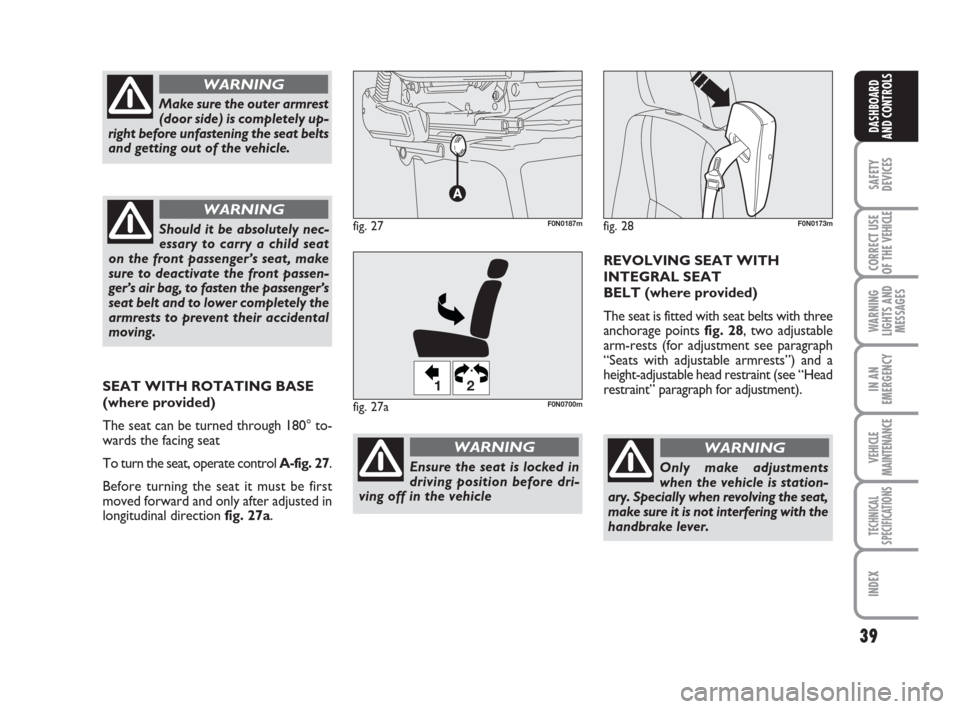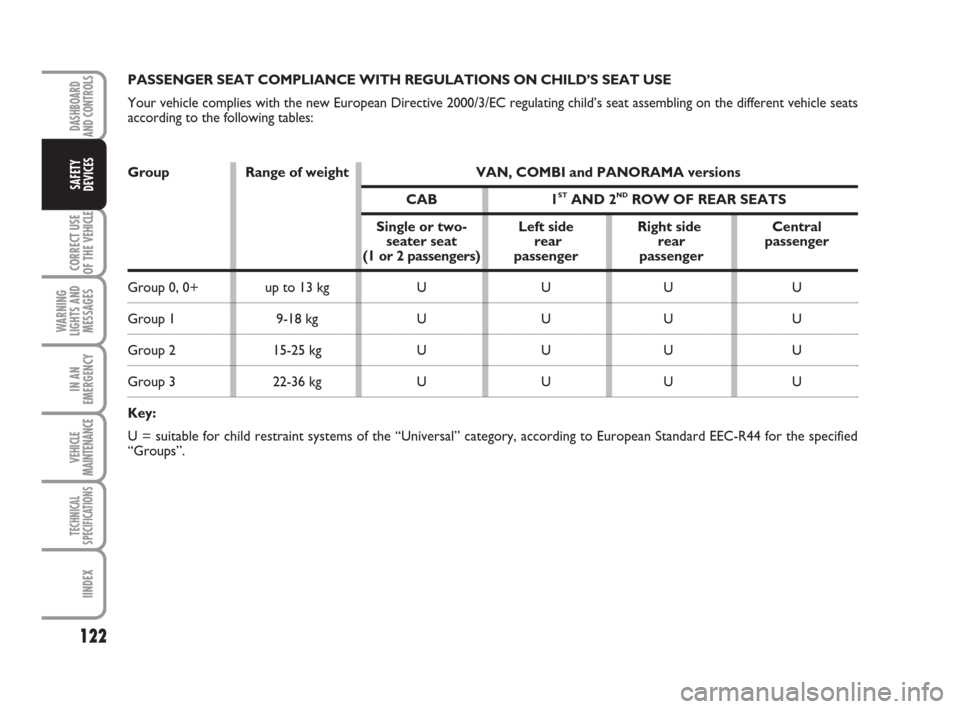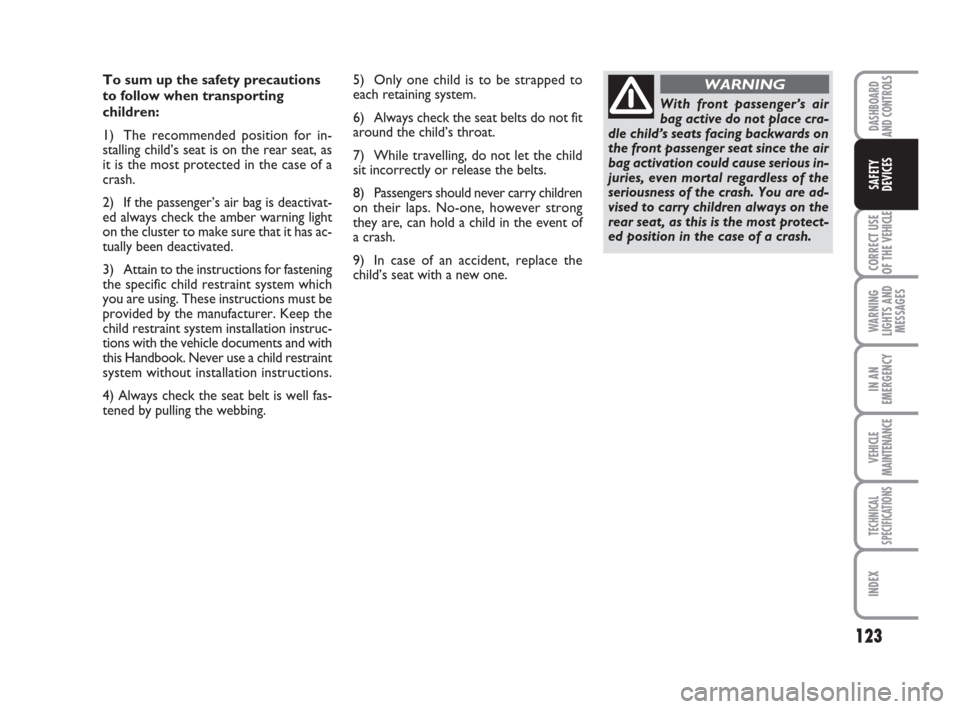2009 FIAT DUCATO child restraint
[x] Cancel search: child restraintPage 40 of 282

39
SAFETY
DEVICES
CORRECT USE
OF THE
VEHICLE
WARNING
LIGHTS AND
MESSAGES
IN AN
EMERGENCY
VEHICLE
MAINTENANCE
TECHNICAL
SPECIFICATIONS
INDEX
DASHBOARD
AND CONTROLS
Only make adjustments
when the vehicle is station-
ary. Specially when revolving the seat,
make sure it is not interfering with the
handbrake lever.
Make sure the outer armrest
(door side) is completely up-
right before unfastening the seat belts
and getting out of the vehicle.
WARNING
Should it be absolutely nec-
essary to carry a child seat
on the front passenger’s seat, make
sure to deactivate the front passen-
ger’s air bag, to fasten the passenger’s
seat belt and to lower completely the
armrests to prevent their accidental
moving.
WARNING
REVOLVING SEAT WITH
INTEGRAL SEAT
BELT (where provided)
The seat is fitted with seat belts with three
anchorage points fig. 28, two adjustable
arm-rests (for adjustment see paragraph
“Seats with adjustable armrests”) and a
height-adjustable head restraint (see “Head
restraint” paragraph for adjustment).
WARNING
fig. 28F0N0173mfig. 27F0N0187m
Ensure the seat is locked in
driving position before dri-
ving off in the vehicle
WARNING
SEAT WITH ROTATING BASE
(where provided)
The seat can be turned through 180° to-
wards the facing seat
To turn the seat, operate control A-fig. 27.
Before turning the seat it must be first
moved forward and only after adjusted in
longitudinal direction fig. 27a.
fig. 27a
12
F0N0700m
Page 114 of 282

113
CORRECT USE
OF THE
VEHICLE
WARNING
LIGHTS AND
MESSAGES
IN AN
EMERGENCY
VEHICLE
MAINTENANCE
TECHNICAL
SPECIFICATIONS
INDEX
DASHBOARD
AND CONTROLS
SAFETY
DEVICES
SEAT BELTS ........................................................................... 113
S.B.R. SYSTEM ....................................................................... 114
PRETENSIONERS.................................................................. 115
CARRYING CHILDREN SAFELY...................................... 119
PRESETTING FOR MOUNTING THE
“UNIVERSAL ISOFIX” CHILD RESTRAINT
SYSTEM.................................................................................... 124
FRONT AIR BAGS................................................................ 126
SIDE AIR BAGS .................................................................... 128
SS S
A A
F F
E E
T T
Y Y
D D
E E
V V
I I
C C
E E
S S
Page 120 of 282

HOW TO KEEP THE SEAT
BELTS ALWAYS IN EFFICIENT
CONDITIONS
Observe the following:
❒always use the belt with the tap taut
and never twisted; make sure that it
is free to run without impediments;
❒after a serious accident, replace the
belt being worn at that time, even if it
does not appear damaged. Always re-
place the seat belts if pretensioners
have been activated;
❒to clean the belts, wash by hand with
neutral soap, rinse and leave to dry in
the shade. Never use strong deter-
gents, bleach or dyes or other chem-
ical substance that might weaken the
fibres;
❒prevent the reels from getting wet:
their correct operation is only guar-
anteed if water does not get inside;
❒replace the seat belt when showing
significant wear or cut signs.For optimal protection in the event of a
crash, all passengers must be seated and
wearing adequate restraint systems.
This is even more important for children.
This prescription is compulsory in all EC
countries according to EC Directive
2003/20/EC.
Compared with adults, their head is pro-
portionally larger and heavier than the rest
of the body, while the muscles and bone
structure are not completely developed.
Therefore, correct restraint systems are
necessary, other than adult seat belts. The
results of research on the best child re-
straint systems are contained in the Euro-
pean Standard EEC-R44. This Standard en-
forces the use of restraint systems classi-
fied in five groups:Group 0 0-10 kg in weight
Group 0+ 0-13 kg in weight
Group 1 9-18 kg in weight
Group 2 15-25 kg in weight
Group 3 22-36 kg in weight
As it may be noted, the groups overlap
partly and in fact, in commerce it is pos-
sible to find devices that cover more than
one weight group.
All restraint devices must bear the certi-
fication data, together with the control
brand, on a solidly fixed label which must
absolutely never be removed.
Over 1.50 m in height, from the point of
view of restraint systems, children are
considered as adults and wear the seat
belts normally.
119
CORRECT USE
OF THE
VEHICLE
WARNING
LIGHTS AND
MESSAGES
IN AN
EMERGENCY
VEHICLE
MAINTENANCE
TECHNICAL
SPECIFICATIONS
INDEX
DASHBOARD
AND CONTROLS
SAFETY
DEVICES
CARRYING CHILDREN SAFELY
Page 123 of 282

122
CORRECT USE
OF THE
VEHICLE
WARNING
LIGHTS AND
MESSAGES
IN AN
EMERGENCY
VEHICLE
MAINTENANCE
TECHNICAL
SPECIFICATIONS
IINDEX
DASHBOARD
AND CONTROLS
SAFETY
DEVICES
PASSENGER SEAT COMPLIANCE WITH REGULATIONS ON CHILD’S SEAT USE
Your vehicle complies with the new European Directive 2000/3/EC regulating child’s seat assembling on the different vehicle seats
according to the following tables:
Group Range of weight VAN, COMBI and PANORAMA versions
CAB 1STAND 2NDROW OF REAR SEATS
Single or two- Left side Right side Central
seater seat rear rear passenger
(1 or 2 passengers) passenger passenger
Group 0, 0+ up to 13 kg U U U U
Group 1 9-18 kg U U U U
Group 2 15-25 kg U U U U
Group 3 22-36 kg U U U U
Key:
U = suitable for child restraint systems of the “Universal” category, according to European Standard EEC-R44 for the specified
“Groups”.
Page 124 of 282

123
CORRECT USE
OF THE
VEHICLE
WARNING
LIGHTS AND
MESSAGES
IN AN
EMERGENCY
VEHICLE
MAINTENANCE
TECHNICAL
SPECIFICATIONS
INDEX
DASHBOARD
AND CONTROLS
SAFETY
DEVICES
To sum up the safety precautions
to follow when transporting
children:
1) The recommended position for in-
stalling child’s seat is on the rear seat, as
it is the most protected in the case of a
crash.
2) If the passenger’s air bag is deactivat-
ed always check the amber warning light
on the cluster to make sure that it has ac-
tually been deactivated.
3) Attain to the instructions for fastening
the specific child restraint system which
you are using. These instructions must be
provided by the manufacturer. Keep the
child restraint system installation instruc-
tions with the vehicle documents and with
this Handbook. Never use a child restraint
system without installation instructions.
4) Always check the seat belt is well fas-
tened by pulling the webbing.5) Only one child is to be strapped to
each retaining system.
6) Always check the seat belts do not fit
around the child’s throat.
7) While travelling, do not let the child
sit incorrectly or release the belts.
8) Passengers should never carry children
on their laps. No-one, however strong
they are, can hold a child in the event of
a crash.
9) In case of an accident, replace the
child’s seat with a new one.
With front passenger’s air
bag active do not place cra-
dle child’s seats facing backwards on
the front passenger seat since the air
bag activation could cause serious in-
juries, even mortal regardless of the
seriousness of the crash. You are ad-
vised to carry children always on the
rear seat, as this is the most protect-
ed position in the case of a crash.
WARNING
Page 125 of 282

124
CORRECT USE
OF THE
VEHICLE
WARNING
LIGHTS AND
MESSAGES
IN AN
EMERGENCY
VEHICLE
MAINTENANCE
TECHNICAL
SPECIFICATIONS
IINDEX
DASHBOARD
AND CONTROLS
SAFETY
DEVICES
PRESETTING FOR
MOUNTING THE
“UNIVERSAL ISOFIX”
CHILD RESTRAINT
SYSTEM
This vehicle is preset for mounting the
Universal Isofix child restraint system, a
new European standardised system for
carrying children safely.
Fig. 11shows a child restraint system by
way of example.
Due to its different anchoring system, the
Universal Isofix child’s seat shall be an-
chored to the proper lower metal rings
A-fig. 12, set between rear seat back and
cushion. The upper belt (provided with
the child’s seat) shall be then secured to
ring B-fig. 13located in the rear part of
the seat.
It is possible to mount at the same time
both the traditional restraint system and
the “Universal Isofix” one.
Remember that in case of Universal Isofix
child’s seat, you can only use all those
seats approved with the marking ECE
R44/03 “Universal Isofix”.
fig. 11F0N0236m
fig. 12F0N0234m
fig. 13F0N0235m
At Lineaccessori Fiat is available the “Uni-
versal Isofix” “Duo Plus” child’s seat.
For any further installation/use detail, re-
fer to the “Instructions Manual” that must
be provided by the child restraint system
Manufacturer.
Mount the child restraint
system only with the vehicle
stationary. The Isofix child restraint
system is properly anchored to the
mounting brackets when clicks are
heard. In any case, keep to the in-
stallation instructions that must be
provided by the child restraint system
Manufacturer.
WARNING
Page 126 of 282

PASSENGER SEAT COMPLIANCE WITH REGULATIONS ON UNIVERSAL ISOFIX CHILD’S SEAT USE
The table below, according to ECE 16 European Directive, shows the different installation possibilities of Universal Isofix restraint
systems on seats fitted with Isofix fasteners.
125
CORRECT USE
OF THE
VEHICLE
WARNING
LIGHTS AND
MESSAGES
IN AN
EMERGENCY
VEHICLE
MAINTENANCE
TECHNICAL
SPECIFICATIONS
INDEX
DASHBOARD
AND CONTROLS
SAFETY
DEVICES
F
G
E
E
D
C
D
C
B1
A Facing backwards
Facing backwards
Facing backwards
Facing backwards
Facing backwards
Facing backwards
Facing backwards
Facing forwards
Facing forwards
Facing forwardsIUF
IUF
IUF
IUF
IUF
IUF
IUF
IUF(*)
IUF
IUFIUF
IUF
IUF
IUF
IUF
IUF(*)
IUF
IUF(*)
IUF
IUF
Range of weight Child’s seat Isofix Vehicle Isofix positions
orientation class side rear side rear 1strowPANORAMA COMBI
Portable cradle
Group 0 to 10 kg
Group 0+ to 13 kg
Group I - 9
to 18 kg
(*) No with front two-seat bench
IUF: suitable for Isofix child restraint systems to be set facing forwards, universal class (fitted with third upper fastener), approved
for the weight group.
Page 271 of 282

270
WARNING
LIGHTS AND
MESSAGES
DASHBOARD
AND CONTROLS
SAFETY
DEVICES
CORRECT USE
OF THE
VEHICLE
IN AN
EMERGENCY
VEHICLE
MAINTENANCE
TECHNICAL
SPECIFICATIONS
INDEX
– jump starting .................................. 158
– recharging........................................ 185
– replacing ......................................... 202
– battery disconnection function ... 83
Bodywork
– maintenance .................................. 208
– version codes ................................ 212
Bonnet .................................................. 98
Brake Assist
(brake assist in an emergency) ....... 103
Brake fluid level.................................... 200
Brakes
– fluid level ........................................ 200
– technical data ................................ 218
Bulb (replacement)
– bulb types ....................................... 168
– general instructions....................... 168
Ceiling lights
– front................................................. 81
– rear................................................... 82
Chassis (marking) ............................... 213
Checking fluid levels............................ 196Child restraint systems
(specifications for use)..................... 119
Cigar lighter ......................................... 87
CO
2exhaust emissions ..................... 265
Code card............................................. 8
Consumption
– engine oil......................................... 198
– fuel.................................................... 264
Containing running costs................... 138
Controls ............................................... 82
Correct use of the vehicle................. 133
Cruise Control .................................... 79
Current outlet...................................... 88
Dashboard (left hand drive version) 5
Dashboard (right hand drive version) 6
Dashboard and controls..................... 4
Dead lock device
– activation/deactivation.................. 94
Digital display........................................ 20
Dimensions .......................................... 223
Dipped beam headlights
– bulb replacement .......................... 171
ABS ...................................................... 102
Accessories purchased by
the user .............................................. 109
Additional climate control system
(rear).................................................... 73
Additional rear heater........................ 72
Air bags (front)..................................... 123
Air bags (side)....................................... 125
Air cleaner............................................. 201
Air vents ............................................... 47
Armrest
– front................................................. 38
Ashtray................................................... 87
ASR ........................................................ 105
– activation/deactivation ................. 105
At the filling station............................. 125
Automatic climate control system .. 55
Automatic headlight sensor
(daylight sensor)................................ 92
Battery
– checking the charge ..................... 202
II I
N N
D D
E E
X X